- Last Updated: November 24th, 2025
Key Takeaways
The Fox River PCB Cleanup has addressed the PCB contamination effectively, with active cleanup completed in 2020.
It is a multifaceted lower fox river project involving various stakeholders, with the Wisconsin DNR playing a key role.
Monitoring and maintenance efforts will continue to ensure long-term success and ecosystem health.
Overview of the Fox River PCB Cleanup
On this page, we’ll discuss an overview of the Fox River PCB cleanup, detailing the PCB remedial actions taken, duration of the Fox River PCB cleanup, and much more.
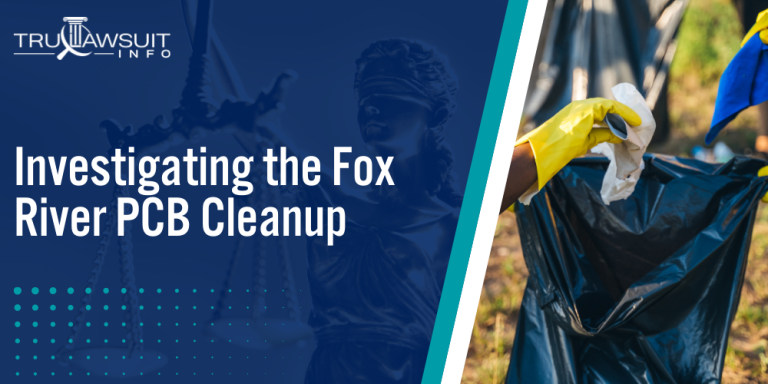
Intro to the Fox River PCB Cleanup
The contamination of the Fox River began in the 1950s through the 1970s when PCBs were widely used in producing carbonless copy paper and other industrial processes.
Key Aspects of PCB Remediation include:
- The cleanup spanned the Lower Fox River, focusing on sediment removal.
- Active remediation began in 2004 with the first Operable Unit (OU1) and proceeded downstream.
- The project reached the Bay of Green Bay (OU5) after extensive efforts.
If you or a loved one has experienced adverse health conditions after being exposed to PCBs in water, you may qualify to pursue compensation.
Contact TruLawsuit Info using the chat on this page to receive an instant case evaluation to determine if you qualify to file a PCB water contamination lawsuit today.
History of PCB Contamination in the Fox River
The Fox River’s legacy of PCB contamination is closely tied to its industrial past, particularly the activities of local pulp and paper mills.
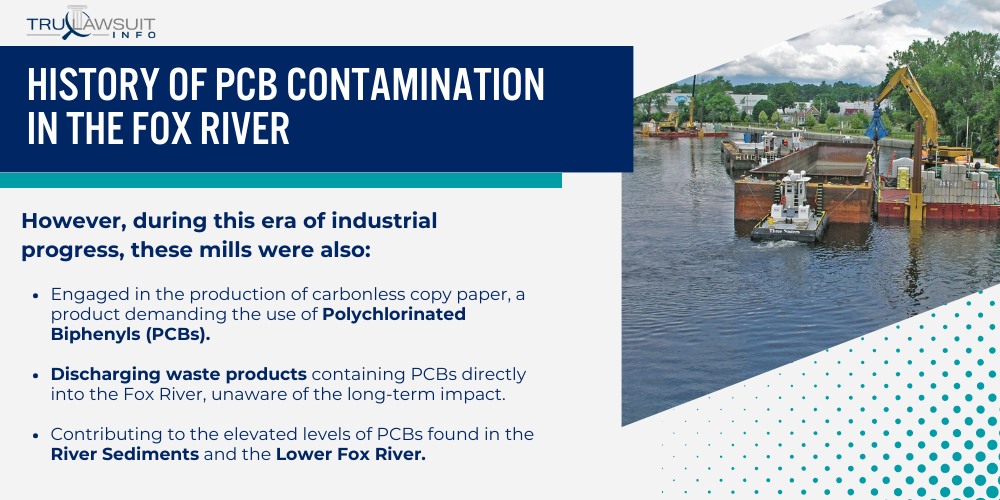
Industrial Discharges of PCBs by Paper Mills
From the mid-1950s through the early 1970s, paper companies along the Fox River, especially near the cities of Menasha and Neenah, were booming industries.
However, during this era of industrial progress, these mills were also:
- Engaged in the production of carbonless copy paper, a product demanding the use of Polychlorinated Biphenyls (PCBs).
- Discharging waste products containing PCBs directly into the Fox River, unaware of the long-term impact.
- Contributing to the elevated levels of PCBs found in the River Sediments and the Lower Fox River.
- Responsible for spreading contamination downstream, ultimately affecting Lake Winnebago and the Menasha and Neenah Channels.
Discovery of Widespread PCB Pollution in River Sediments
In a groundbreaking environmental study, scientists uncovered alarming levels of polychlorinated biphenyls (PCBs) in the sediments of the Fox River, marking a critical environmental crisis.
This discovery highlighted the urgent need for action to address the pervasive pollution affecting the river’s ecosystem and the health of local communities.
The realization of the Fox River’s contamination took center stage when:
- Environmental Protection Agency (EPA) investigations found that PCB-contaminated sediment spanned nearly the entire length of the river.
- Subsequent studies identified high levels of PCBs in the sediments, which led to serious concerns for wildlife and human health.
- Concerns prompted further inquiry, revealing that PCB concentrations were far above safe levels, threatening the local ecosystem.
- These findings became the driving force for one of the largest river sediment cleanup efforts handled by the EPA.
Meticulous records and consistent monitoring by the EPA ever since then have been critical to tracking progress and ensuring the health of the Fox River and its surrounding environments.
Health and Environmental Impacts of Fox River PCBs
Polychlorinated biphenyls (PCBs) from the historic activities along the Fox River have led to significant environmental contamination and health concerns.

These substances linger in the river ecosystem, causing harm to both human health and wildlife populations.
Risks to Human Health from PCB Exposure
PCBs are known to cause a range of health hazards to people who are exposed to them, particularly through consumption of contaminated fish.
Due to their persistence in the environment and bioaccumulation in the food chain, PCB exposure can lead to various health effects.
Here are some of the key health concerns associated with PCB exposure:
- Cancer Risk: Exposure to PCBs has been linked to an increased risk of certain cancers.
- Immune System Effects: PCBs can affect the human immune system, making it difficult for the body to fight infections.
- Reproductive Issues: High levels of exposure may lead to reproductive health problems in both men and women.
- Neurological Development: In children, PCBs can impact neurological development, potentially causing learning difficulties and behavioral problems.
These concerns have prompted long-term testing of fish tissue, as well as ongoing monitoring of PCB concentrations in the river.
Adverse Effects on Fish and Wildlife Populations
The presence of PCBs in the Fox River has had detrimental impacts on fish and wildlife populations.
The Wildlife Service and other conservation agencies have noted the following effects:
- Toxic Buildup: Wildlife, especially fish, accumulate PCBs in their tissue, leading to toxic exposure levels.
- Population Declines: Certain species of fish and wildlife have experienced population declines due to PCB toxicity.
- Habitat Degradation: Contaminated sediments have degraded habitats that are essential for the reproductive and feeding cycles of various species.
- Natural Resources Damaged: PCB pollution has damaged critical natural resources, affecting the entire ecosystem’s health.
Ongoing cleanup efforts aim to mitigate these impacts and restore the quality of natural habitats along the Fox River.
The Fox River PCB Cleanup Project
The Fox River PCB Cleanup Project represents a significant environmental restoration effort, focusing on eliminating hazards from polychlorinated biphenyls (PCBs) in the river’s sediment.
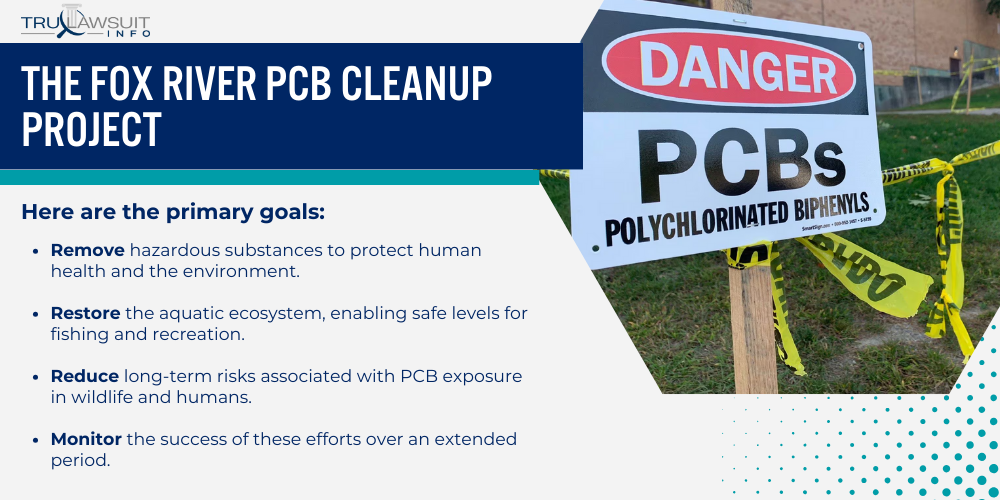
Scope and Goals of the Remediation Effort
The Lower Fox River Cleanup aimed to remediate sediment along 39 miles of the river, heavily targeted due to historic PCB contamination.
Here are the primary goals:
- Remove hazardous substances to protect human health and the environment.
- Restore the aquatic ecosystem, enabling safe levels for fishing and recreation.
- Reduce long-term risks associated with PCB exposure in wildlife and humans.
- Monitor the success of these efforts over an extended period.
Dredging and Disposal Techniques Employed
Sophisticated techniques were imperative in the Cleanup Effort.
Let’s walk through the steps taken:
- Engineered dredging was used to extract contaminated sediments with precision.
- Hydraulic dredging removed over 6.5 million cubic yards of contaminated material.
- Capping involved strategically placing layers over certain areas to contain PCBs.
- Long-term monitoring of caps ensures their effectiveness and stability.
Challenges Faced During the Fox River Cleanup
The cleanup of the Fox River was a significant undertaking that faced numerous hurdles, particularly in understanding regulatory requirements and managing local community opinions.

Analyzing the Regulatory Requirements
Meeting regulatory standards was a demanding aspect of the Fox River cleanup project.
The cleanup teams had to coordinate with various agencies, each with its own set of guidelines.
The following entities played a crucial role in setting and enforcing these guidelines:
- Wisconsin Department of Natural Resources (WDNR): Ensured state-level compliance and monitored the cleanup’s progress.
- United States Environmental Protection Agency (EPA): Provided federal guidelines for PCB removal and disposal.
- Local Regulations: Included additional local stipulations to the existing state and federal guidelines.
- Record of Decision (ROD): Required rigorous compliance with comprehensive cleanup plans and targets.
Each of these regulatory avenues had overlapping jurisdictions, which made integrating their respective requirements a challenge that required carefully planned strategies to address.
Addressing Community Concerns and Opposition
Handling community concerns was equally challenging.
The cleanup project had to address a variety of issues that were raised by businesses and residents in the region.
Key issues that surfaced from community feedback included:
- Economic Impacts: Local industries were worried about interruptions to their operations and potential financial implications.
- Environmental Concerns: Residents and environmental groups voiced their worries about the ongoing health impact of PCBs and potential risks during the cleanup.
- Recreational Use: The Fox River is a hub for recreational activities, and access limitations during cleanup led to public pushback.
- Information Dissemination: Ensuring accurate and timely information reaches the community to maintain transparency and build trust.
Collaboration with the Wisconsin Department was essential to address these concerns adequately and to keep the public informed about the motives, progress, and safety measures of the cleanup project.
Progress and Milestones in the Fox River PCB Cleanup
The Fox River cleanup represents a significant environmental undertaking, with a clear focus on removing contaminated sediment and enhancing the ecosystem’s health.
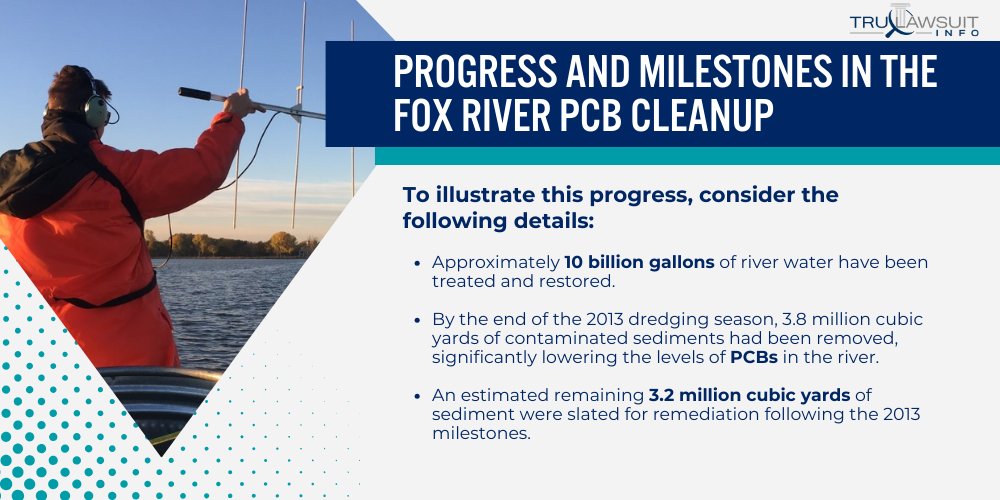
Over years of effort, remarkable milestones have been achieved in the cleanup operations, with substantial volumes of sediments addressed and meaningful improvements in water quality.
Volumes of Contaminated Sediment Removed
Substantial quantities of PCBs have been extracted or contained during the cleanup, leading to a significant reduction in environmental hazards.
To illustrate this progress, consider the following details:
- Approximately 10 billion gallons of river water have been treated and restored.
- By the end of the 2013 dredging season, 3.8 million cubic yards of contaminated sediments had been removed, significantly lowering the levels of PCBs in the river.
- An estimated remaining 3.2 million cubic yards of sediment were slated for remediation following the 2013 milestones.
- The cleanup operations successfully covered 780 acres with sand covering to secure the remediated riverbed.
Improvements in Water Quality and Ecosystem Health
The efforts to clean up the Lower Fox River have yielded positive outcomes, contributing to the recovery of the river and surrounding areas.
Key improvements include:
- The project’s active remediation phase ended in 2020, marking the end of significant cleanup efforts by the Environmental Protection Agency and other partners.
- The systematic and thorough removal of hazardous PCBs has enhanced water quality, benefiting both human and wildlife populations.
- Long-term monitoring of sediment caps, fish populations, and water is set to continue, ensuring the ongoing health of the river ecosystem.
- Positive feedback from wildlife officials highlights the cleanup’s role in supporting the rebound of natural resources in the area.
This section of the cleanup process emphasizes the rigorous approach taken to remediate a key natural waterway and reflects a commitment to environmental protection and restoration.
Ongoing Monitoring and Maintenance Efforts
The remediation of the Fox River PCB contamination is an ongoing effort that requires vigilant long-term monitoring and adaptive management to ensure the protection of the environment and public health.
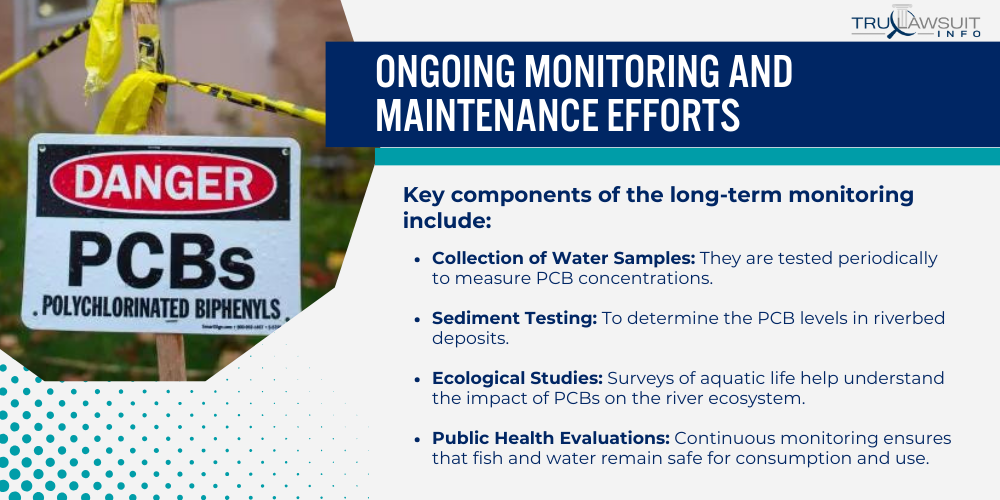
Long-Term Monitoring of PCB Levels in the Fox River
To assess the effectiveness of cleanup activities, regular monitoring of PCB levels in the Fox River is critical.
This process evaluates the river’s current state and ensures that the remediation strategies implemented continue to meet the safety benchmarks.
Key components of the long-term monitoring include:
- Collection of Water Samples: They are tested periodically to measure PCB concentrations.
- Sediment Testing: To determine the PCB levels in riverbed deposits.
- Ecological Studies: Surveys of aquatic life help understand the impact of PCBs on the river ecosystem.
- Public Health Evaluations: Continuous monitoring ensures that fish and water remain safe for consumption and use.
Adaptive Management Strategies for Continued Remediation
The Fox River cleanup project incorporates adaptive management strategies to address any changes or unexpected challenges that arise during the long-term maintenance phase.
In practice, this means:
- Adjusting Remediation Techniques: Depending on the results from ongoing monitoring, methods may be tweaked for effectiveness.
- Enhancing Sediment Caps: If monitoring indicates that there’s leaching through caps, they might be reinforced or redesigned.
- Tweaking Monitoring Protocols: Feedback from current processes can streamline future monitoring efforts.
- Community Engagement: Keeping the public informed and involved in the cleanup progress is an important aspect of adaptive management.
Stakeholder Involvement in the Fox River Cleanup
The cleanup of PCBs in the Fox River is a collaborative effort involving varied stakeholders, each playing a pivotal role, from government agencies to local communities and industries.
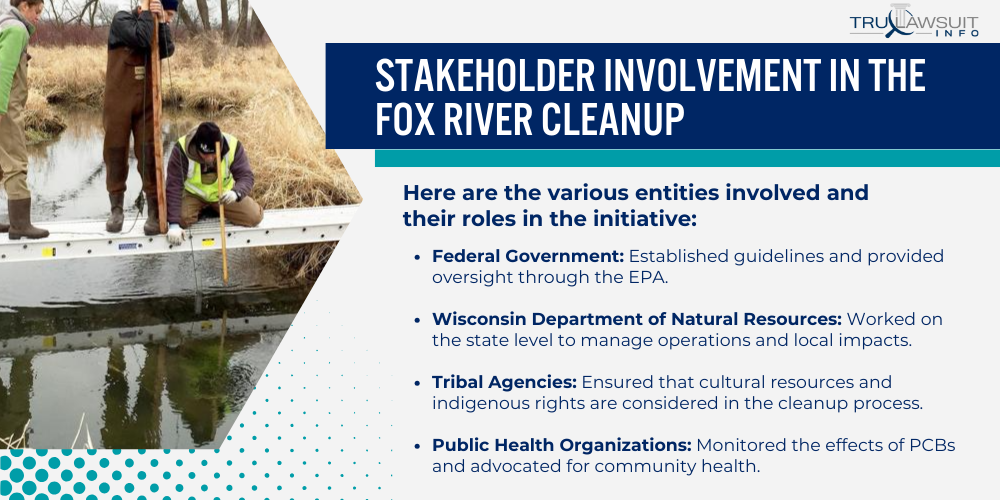
Roles of Government Agencies, Industry, and NGOs
Government agencies have been at the forefront of the Fox River cleanup.
The Environmental Protection Agency (EPA) and the Wisconsin Department of Natural Resources (DNR) have led the regulatory and supervisory efforts to ensure the cleanup adheres to legal and environmental standards.
Here are the various entities involved and their roles in the initiative:
- Federal Government: Established guidelines and provided oversight through the EPA.
- Wisconsin Department of Natural Resources: Worked on the state level to manage operations and local impacts.
- Tribal Agencies: Ensured that cultural resources and indigenous rights are considered in the cleanup process.
- Public Health Organizations: Monitored the effects of PCBs and advocated for community health.
Industry stakeholders, particularly NCR Corp and Georgia Pacific, have been responsible for funding and executing significant parts of the cleanup following litigation that held them responsible for the contamination.
The contributions of these companies were significant in the overall effort:
- NCR Corp: Took on a lead role in funding and performing the sediment cleanup as directed by a consent decree.
- Georgia Pacific: Involved in the cleanup efforts as one of the identified polluters contributing to the Fox River contamination issue.
Non-governmental organizations (NGOs) have been instrumental in research, advocacy, and raising public awareness about the ecological and health impacts of PCBs in the Fox River.
Public Participation and Community Outreach Initiatives
Public Participation has been a key factor in the success of the Fox River cleanup initiative.
Ensuring the local community is informed and engaged leads to better outcomes and greater compliance with regulations.
To facilitate this, several approaches were adopted:
- Community meetings and public forums were conducted for transparency.
- Information sessions were held to educate residents about PCB impacts.
- Local impact consultations were done to understand the public concerns.
- Feedback mechanisms were established for continuous community input.
Community Outreach initiatives by various entities sought to keep the public informed and involved in the cleanup process.
In support of these efforts, various platforms and programs were utilized:
- The Wisconsin Examiner played a role in reporting on the efforts and progress of the cleanup.
- Educational programs were developed to inform school children about environmental stewardship.
- Volunteer opportunities were organized to get locals actively involved in supplementary cleanup activities.
- Websites and social media were used effectively to disseminate information and updates.
Through these collective efforts, stakeholders continue to progress towards a cleaner and healthier Fox River, reducing the risks posed by PCBs to humans and wildlife.
Lessons Learned from the Fox River PCB Cleanup
The Fox River PCB cleanup project, one of the most significant of its kind, has provided valuable insights into environmental remediation strategies and the effectiveness of long-term ecological recovery efforts.
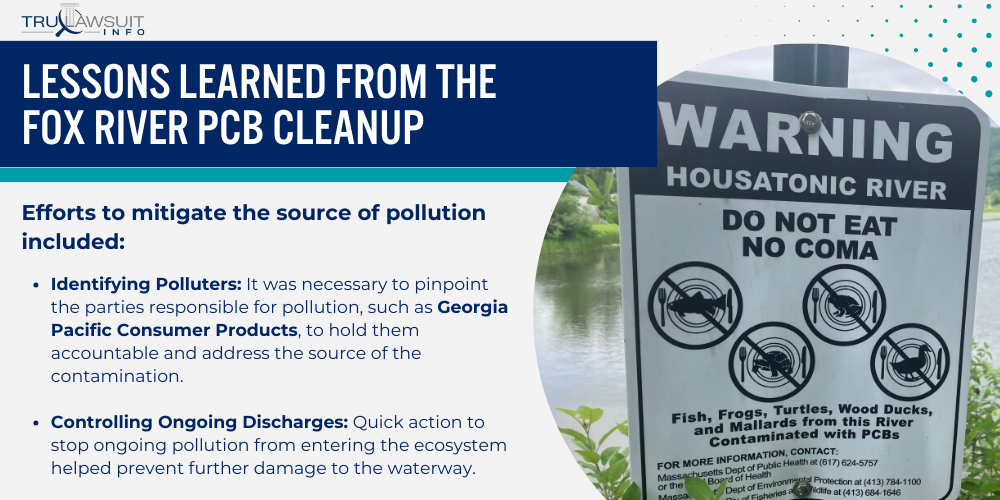
Importance of Early Intervention and Source Control
Early intervention has emerged as a pivotal factor in the success of environmental cleanup operations.
In the case of the Fox River cleanup, actions taken to control the source of pollution had a substantial impact on the overall outcome of the project.
Efforts to mitigate the source of pollution included:
- Identifying Polluters: It was necessary to pinpoint the parties responsible for pollution, such as Georgia Pacific Consumer Products, to hold them accountable and address the source of the contamination.
- Controlling Ongoing Discharges: Quick action to stop ongoing pollution from entering the ecosystem helped prevent further damage to the waterway.
- Regulatory Coordination: Effective collaboration with state spill authorities ensured prompt response to leakage and spills.
- Long-Term Commitment: The complexity of the cleanup operation required a sustained effort and commitment to early intervention strategies to see improvements.
Need for Comprehensive Remediation Planning and Execution
Thorough and strategic planning is key to the successful remediation of any Superfund site.
The Fox River cleanup efforts showcased the imperative of a well-structured approach.
Critical components of the planning and execution process included:
- Extensive Research: Prior to remediation, extensive research is essential to understand the full extent of contamination and ecosystem impacts.
- Adaptive Strategies: The project adapted techniques as needed, choosing from dredging, capping, and other methods to suit different areas of the river.
- Monitoring and Adjustment: Continuous monitoring was necessary for adapting the cleanup process and ensuring progress towards the Wisconsin Certified Completion.
- Stakeholder Engagement: Regular communication with the community and involved stakeholders provided transparency and helped in managing environmental and public health concerns effectively.
This Superfund site showed the importance of precise execution of cleanup strategies, with detailed attention to both remediation activities and ecological restorations, leading to a State Closure that reflects the success of these comprehensive efforts.
The Future of the Fox River After PCB Remediation
With the completion of the Fox River PCB cleanup effort, new chapters are beginning for both the ecology and the communities along its banks.
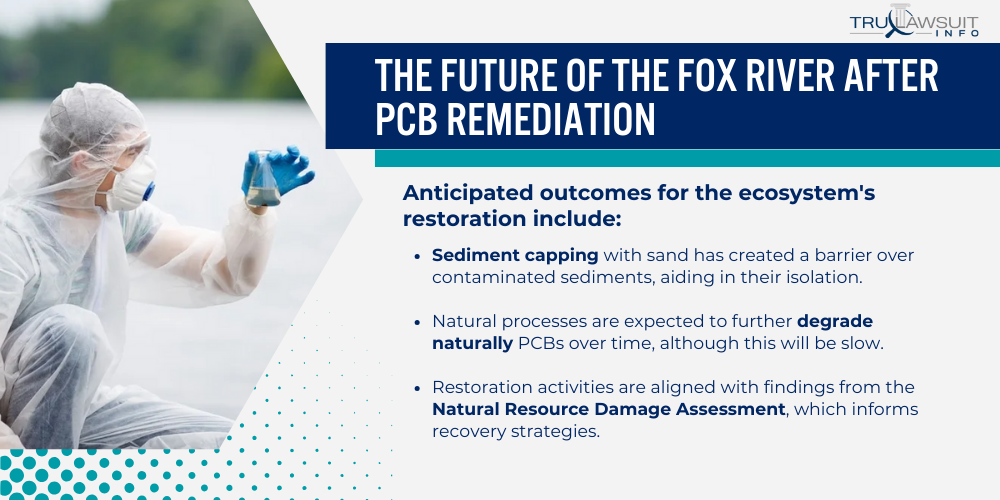
The river system, once hampered by pollutants, is anticipated to heal and offer enhanced opportunities for natural and human endeavors alike.
Expected Ecological Recovery and Restoration
The extensive cleanup has set the stage for significant ecological improvements.
The river, which flows northeast through Northeastern Wisconsin, including the Neenah Channels, will likely see a resurgence of fish and wildlife as conditions improve.
Anticipated outcomes for the ecosystem’s restoration include:
- Sediment capping with sand has created a barrier over contaminated sediments, aiding in their isolation.
- Natural processes are expected to further degrade naturally PCBs over time, although this will be slow.
- Restoration activities are aligned with findings from the Natural Resource Damage Assessment, which informs recovery strategies.
- Monitoring will continue, ensuring that the highest concentration areas, such as Lake Butte des Morts, recover as anticipated.
Opportunities for Recreational Use and Economic Development
The remediation efforts herald promising times ahead for recreation and local economies.
As the Fox River’s health is restored, we can expect:
- Enhanced water quality will attract more recreational use, with cleaner waters for fishing and boating.
- Northeastern Wisconsin and areas like Green Bay can anticipate growth in tourism, benefiting from a healthier river ecosystem.
- Economic development related to increased recreational use will spur local business opportunities.
- The cleaner Fox River and Green Bay enhance the allure for potential residents, boosting property values and community investments.
The transition from a river contaminated with PCBs to one that again sustains vibrant ecosystems and thriving communities serves as a testament to the resilience of nature and the value of joined efforts in environmental remediation.
Frequently Asked Questions
-
The full-scale remediation of the Lower Fox River began in 2004 and was completed in 2020; monitoring of the sediments, fish populations, and water quality is set to continue for the foreseeable future.
An official update can be found on the Cleanup Operations | Wisconsin DNR webpage.
-
Maps detailing remediation efforts and cleaned areas along the Lower Fox River can be accessed through resources provided by the Wisconsin Department of Natural Resources (DNR).
The latest maps are available on the Fox River | Wisconsin DNR website.
-
Those interested in volunteering can contact local environmental organizations or the Wisconsin Department of Natural Resources for opportunities.
The DNR often coordinates events and can provide guidance on how to contribute to Fox River’s health.
-
Extensive measures were taken in Wisconsin for sediment removal, capping activities, and ongoing ecosystem monitoring.
-
Efforts in Illinois have focused on controlling point sources of pollution, enhancing wastewater treatment facilities, and ongoing public education campaigns to reduce pollutant runoff.
Specific efforts and progress may differ from those in Wisconsin due to variations in industrial impact and state policies.
-
The Superfund designation brought significant resources and attention, leading to the comprehensive cleanup of over 14 million yards of contaminated sediment and a reduction in annual PCB discharge into Green Bay.
For more background, the Case Summary: NCR Corporation Agrees to End Litigation and Complete PCBs Cleanup provides insight into the impact and scope of the cleanup efforts.

Attorney Jessie Paluch, founder of TruLawsuit Info, has over 25 years of experience as a personal injury and mass tort attorney, and previously worked as an international tax attorney at Deloitte. Jessie collaborates with attorneys nationwide — enabling her to share reliable, up-to-date legal information with our readers.
Legally Reviewed
This article has been written and reviewed for legal accuracy and clarity by the team of writers and legal experts at TruLawsuit Info and is as accurate as possible. This content should not be taken as legal advice from an attorney. If you would like to learn more about our owner and experienced injury lawyer, Jessie Paluch, you can do so here.
Fact-Checked
TruLawsuit Info does everything possible to make sure the information in this article is up to date and accurate. If you need specific legal advice about your case, contact our team by using the chat on the bottom of this page. This article should not be taken as advice from an attorney.
You can learn more about the PCB Exposure Lawsuit by visiting any of our pages listed below:
Here, at Tru Lawsuit Info, we’re committed to helping victims get the justice they deserve.
To do this, we actively work to connect them with attorneys who are experts in litigating cases similar to theirs.
Table of Contents
Tru Lawsuit Info is a reliable source of information about issues that may affect your health and safety, such as faulty products, data breaches, and environmental hazards.
Our team of experienced writers collaborates with medical professionals, lawyers, and advocates to produce informative articles, guides, and other resources that raise awareness of these topics.
Our thorough research provides consumers with access to reliable information and updates on lawsuits happening around the country. We also can connect consumers with attorneys if they need assistance.
Here, at Tru Lawsuit Info, we’re committed to helping victims get the justice they deserve.
To do this, we actively work to connect them with attorneys who are experts in litigating cases similar to theirs.
